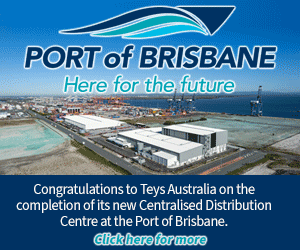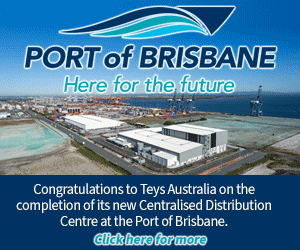Teys Australia has implemented innovative automated solutions for handling and shipping beef products from its facility in the Port of Brisbane, Queensland. The new Centralised Distribution Centre uses an Automated Storage Retrieval System (ASRS) to handle incoming beef, scanning each individual carton and allocating a unique position in the ASRS. Once an order is placed, the ASRS retrieves individual cartons and directs them to robots to create the required pallets, which then go into a separate automated pallet cold store, ready for shipment. The system also features a custom warehouse management system and an automated pallet exchange system. Another advantage of the new Teys system is in the area of empty pallet handling, with a re-usable plastic slip sheet negating the need for the familiar blue Chep wooden pallets. The new Teys facility is the first ‘high-bay’ warehouse installation on reclaimed sandy soil like this on the Port of Brisbane.
Teys Australia Invests $100m in Beef’s Future with Automated Distribution Centre
Teys Australia has recently completed its new $100m Centralised Distribution Centre at the Port of Brisbane, equipped with robotics, autonomous vehicles and automated handling systems. The facility is a prime example of how Australia can remain competitive in the global red meat market by producing high-quality, consistent, safe and traceable product, while increasing efficiency to combat low-cost export competitors like Brazil.
Teys Australia’s Centralised Distribution Centre
The new Centralised Distribution Centre at the Port of Brisbane represents the biggest infrastructure investment made by Teys in the last decade. The facility is equipped with autonomous computer-controlled vehicles, robotics, and world-class inventory management and sortation technology.

It aggregates chilled and frozen beef from Teys’ three largest export beef processing plants, located in Queensland, and can also handle products from its southern Australian plants at Wagga and Naracoorte. The product is consolidated at the Port of Brisbane site and then shipped for export or distributed for domestic Australian market use.
Inter-Linked Technologies
The Port of Brisbane site incorporates a vast suite of technologies designed to streamline and enhance the meat handling, logistics, and export process. The facility’s operations are driven by a combination of internal warehouse management systems developed by Teys and technology suppliers such as Dematic, Blue Yonder, and Riantics.
Key Advantages of the New Site
Previously, Teys Australia’s three large regional Queensland beef plants consolidated their own chilled and frozen beef in cold storage on each site, and then trucked it straight to the port for loading or to a conventional cold store at nearby Hemment. The new site differs by consolidating products from the three Queensland plants, which increases efficiency and reduces costs.
The $100m investment made by Teys Australia in the Centralised Distribution Centre at the Port of Brisbane represents a huge commitment in beef’s future. The facility’s advanced technology will help Australia retain its competitive edge in the global red meat market.
Teys Australia’s Centralised Distribution Centre: A Technological Marvel That Addresses Beef Inventory Challenges
Teys Australia, like all beef processors, faces challenges in managing its growing inventory manually across its processing sites. The proliferation of beef product types, including brand, age, grass/grain, HGP use, Halal, and other attributes, has resulted in hundreds of product categories that need to be managed separately.
To address this issue, Teys Australia built the new Centralised Distribution Centre at the Port of Brisbane, which aggregates and consolidates beef products from three of its largest export beef processing plants in Queensland. With the capability to handle 48,000 cartons in and out every day, operating 22 hours a day, the facility can store up to 7,000 tonnes of chilled and frozen beef products.
A Technological Marvel
The new facility is equipped with robotics, autonomous computer-controlled vehicles, and world-class inventory management and sortation technology, making it capable of managing inventory under high degrees of computer control and automation. The implementation of the technology has helped Teys Australia save an enormous amount of labor and reduce mistakes in order fulfillment to almost zero.
A Huge Commitment to Beef’s Future
With a $100m investment in land, buildings, and state-of-the-art equipment and technology, the Centralised Distribution Centre is the biggest infrastructure investment made by Teys in the past decade. The facility aims to retain Australia’s competitive edge in the global red meat market by producing high-quality, consistent, safe, and traceable beef products with increasing efficiency to combat low-cost export competitors like Brazil.
The Advantages of the Centralised Distribution Centre
By consolidating beef products from three of its largest export beef processing plants in Queensland, the facility has reduced the time taken to get products into export markets by up to a week. The new Brisbane facility operates with just 20 personnel per shift and is expected to reduce 160 staff from the previously manually managed process when the current stage of development is fully completed next year. This outcome is achieved by automating the pallet loading back at each plant.
Teys Australia believes that there is not another facility in the world that aggregates and consolidates red meat products from multiple large processing sites at this scale while managing inventory under high degrees of computer control and automation.
The new facility is not just about storing beef products; it is about turning over the product faster with greater accuracy, providing better outcomes for customers, and creating good jobs by removing difficult work for employees. Going from 14 days inventory to ten days’ represents a lot of money for the company.
The Centralised Distribution Centre at the Port of Brisbane is a technological marvel that addresses inventory challenges and demonstrates Teys Australia’s huge commitment to beef’s future.
Teys Australia’s Centralised Distribution Centre: A Unique Facility with Inter-Connected Technologies
Teys Australia’s brand new Centralised Distribution Centre at the Port of Brisbane is a prime example of how beef processors are finding ways to produce high-quality, consistent, safe, and traceable products with increasing efficiency. The facility is equipped with a fully automated palletised storage and retrieval system and a fleet of 50 autonomous guided vehicles (AGVs) that ferry incoming and outgoing product around the facility.
A Five-Year Project
The project has been in development for five years, with much of 2018 spent in design, and construction works commencing during late 2019. The building was contracted to Toowoomba Builder McNab, and the extensive fit-out started in mid-2020. The facility was operational last year, after the first small trial shipments in January.
IT Challenges
Significant IT challenges were involved in getting the entire network to operate seamlessly, but Teys Australia’s Chairman and acting Chief Executive, Brad Teys, said that the IT system is getting “horribly close” to operating seamlessly. Liam Maher, the facility’s General Manager, said that it was necessary to either enhance or introduce seven new software applications for the project, and they all had to “talk to each other.”
A World-First Technology
A unique feature of the facility is that it is the first example in the global red meat industry of bringing together the full suite of new technologies used in product storage, handling, and distribution. The facility’s automated palletised meat storage and retrieval system can stack pallets up to eight high, all without human intervention, using high-speed robotic cranes. The AGVs ferry incoming and outgoing product around the facility, making it more efficient.
The interlinking of these technologies is breaking new ground in the global red meat industry. The data flow between all the systems has been challenging, but the facility includes built-in warnings and over-rides if a human-error mistake occurs in ordering. The process uses a system where each customer order card is set up with what they can (and can’t) access, and the robots will build to that or advise when a mistake is made.
The Advantages of the Centralised Distribution Centre
The Centralised Distribution Centre has several advantages, including reducing mistakes in order fulfillment to almost zero and reducing the time taken to get the product into export markets by up to a week. The facility has the capacity to store up to 7,000 tonnes of chilled and frozen beef products and can handle 48,000 cartons in and out every day, operating 22 hours a day.
Conclusion
Teys Australia’s Centralised Distribution Centre at the Port of Brisbane is a technological marvel that demonstrates the beef industry’s commitment to finding new and innovative ways to remain internationally competitive in the global red meat market. The inter-connected technologies used at the facility are breaking new ground in the global red meat industry, and the facility’s unique features are making it more efficient and accurate.
Teys Australia’s new Centralised Distribution Centre at the Port of Brisbane is a prime example of the company’s efforts to remain competitive in the global red meat market. The $100m facility, the biggest infrastructure investment made by Teys in the past decade, is equipped with state-of-the-art technologies to handle meat storage, handling, and distribution, and is manned by just 20 personnel per shift. The facility aggregates chilled and frozen beef from three of Australia’s largest export beef processing plants, all in Queensland, and is capable of handling 48,000 cartons in and out every day, operating 22 hours a day. The site has the capacity to store 7000 tonnes of chilled and frozen product, with about 60% of it in frozen form.
The Challenges
Part of the challenge for Teys and other beef processors is that there has been greater differentiation of products over time, producing hundreds of product categories, making inventory a growing nightmare to manage manually, site-by-site, when trying to fill customer orders.
Five Years in the Making
The project has been five years in the making, with construction work commencing in late 2019, and the extensive fit-out starting in mid-2020. The facility employs a fleet of 50 small autonomous vehicles called Automated Guided Vehicles (AGVs) to transport pallets of beef through the facility, and each AGV returns to one of three docking stations when it needs recharging. A unique feature at the site is that it is the first example in the global red meat industry of bringing together the full suite of new technologies used in product storage, handling, and distribution.
Key Technologies
The site incorporates a vast suite of interlinked technologies designed to streamline and enhance the meat handling, logistics, and export process. The key technologies include:
-
Automated palletised meat storage and retrieval: The vast storage can stack pallets up to eight high, all without human intervention, using high-speed robotic cranes.
-
Dematic’s Multi-shuttle automated storage and retrieval handling system: Used for individual cartons of beef, each Dematic storage is more than 20 metres in height, and has the capacity to handle more than seven million cartons per year. The system makes stocktake an unbelievably simple process.
-
Custom warehouse management system: Builds custom-packed orders on pallets, drawing from the inventory held on the database to retrieve specific individual cartons to build pallets ready for shipment – all using robotics.
-
Automated pallet exchange system: For inserting pallets when supplying the domestic market.
How the Process Works
As a delivery of beef arrives at the Port of Brisbane facility from a plant, the automated process starts like this:
-
Each mixed pallet of incoming beef is transported by one of the AGVs to a de-palletising area and unpacked by robots into separate cartons onto a conveyor.
-
Each individual carton is then scanned and identified and allocated a unique position in the Automated Storage Retrieval System (ASRS), where cartons are stored either chilled or frozen.
-
A custom warehouse management system builds custom-packed orders on pallets, drawing from the inventory held on the database to retrieve specific individual cartons to build pallets ready for shipment, all using robotics.
-
Each order is then quality checked before loading onto a truck for delivery or a ship for export.
Benefits
The new facility has knocked up to a week off the time taken to get the product into export markets, and reduced mistakes in order fulfillment to almost zero. It has also taken repetitive, boring manual tasks out of the chain, providing better outcomes for customers and creating good jobs by removing difficult work for employees. The automated process has eliminated mis-ordering, previously a significant problem when manual handling was involved.
Teys Australia, one of Australia’s largest beef processors, has opened a state-of-the-art centralised distribution facility in Brisbane that is now considered to be the most advanced meat-processing plant in the world. The new facility was developed to deal with the challenge of managing inventory in the face of a proliferation of different beef products, with brands, ages, grass/grain, HGP use, Halal and other attributes producing hundreds of product categories. The solution was to create a strategically located facility that centralised distribution, saved an enormous amount of labour, and reduced mistakes in order fulfilment to almost zero. The fully-automated facility has been five years in the making, with the construction work commencing in 2019, and comprises a range of technologies, many of which are interconnected for the first time anywhere in the global red meat industry.
Automated technologies
The facility uses an extensive range of technologies, including:
-
Automated Guided Vehicles (AGVs): small autonomous computer-instructed vehicles used to transport pallets of beef through the facility. The facility employs a squad of 34 electric AGVs, which automatically return to one of three 13 docking stations when they need recharging.
-
Dematic’s Multi-shuttle automated storage and retrieval handling system for individual cartons of beef: this technology, which has been around for several years, is interlinked with other systems to break new ground in the industry.
-
A custom warehouse management system that uses robotics to build custom-packed orders on pallets, eliminating mis-ordering that occurred when manual handling was involved.
-
An automated pallet exchange system for inserting pallets when supplying the domestic market.
The Process
When a delivery of beef arrives at the Port of Brisbane facility, the automated process starts by transporting each mixed pallet of incoming beef by one of the autonomous vehicles to a de-palletising area, and unpacking it by robots into separate cartons onto a conveyor. Each individual carton is then scanned, identified, and allocated a unique position in the Automated Storage Retrieval System (ASRS), where cartons are stored either chilled or frozen. Once a customer order is placed, and enough cartons with the right spec are available in storage, the ASRS retrieves individual cartons matching that order from the storage, and directs them to robots to make up the required pallets. From there, the stacked pallet of customer-ready beef goes into a separate automated pallet cold store, ready for shipment. Once the correct number of pallets are available to fill a container order and the container is available, they are retrieved and loaded into the final shipping container, ready for transport to the stevedores next door.
Benefits
The benefits of the new system include greater efficiency and accuracy in inventory management, with stocktake becoming an unbelievably simple process. Complex orders and customer or market requirements pose many challenges, but the systems have been able to provide solutions to most of these challenges so far with a few software enhancements still to be finalised. The new Teys system takes into account the dimensions of each individual incoming carton, designing a pallet packing strategy that best utilises over or under-sized cartons to create a more rigid and stable pallet of beef, less likely to become loose or dislodge during transport. The system has become an attraction to customers, enabling Teys to sort containers with 18 or 20 cuts of beef, compared to the standard 12-cut set of Australian beef.
Teys Australia, one of Australia’s biggest meat processors, has opened a Centralised Distribution Centre (CDC) in Brisbane, a facility that has taken five years to develop. This high-tech warehouse facility for storing and moving chilled and frozen beef is a world-first, bringing together a full suite of new technologies used in product storage, handling, and distribution.
Automated Guided Vehicles (AGVs)
The CDC employs a squad of 34 small autonomous vehicles known as Automated Guided Vehicles (AGVs), which transport pallets of beef through the facility. Once they need recharging, these AGVs automatically return to one of three docking stations. An operating system guides the ‘missions’ of each AGV, right down to removing waste pallet wrapping materials for recycling or returning empty pallets.
Automated storage and retrieval handling system
The CDC features a Dematic’s Multi-shuttle automated storage and retrieval handling system for individual cartons of beef. Each Dematic storage is more than 20 metres in height, and with more than seven million cartons passing through the facility last year, the system operators have never once asked for the whereabouts of a carton and not got an accurate response. The system is designed to eliminate mis-ordering from the process when manual handling was involved.
Custom warehouse management system
A custom warehouse management system is used to build custom-packed orders on pallets, drawing from the inventory held on the database to retrieve specific individual cartons to build pallets ready for shipment, all using robotics. It’s not unusual for the system to select cartons of beef carrying the same spec from up to three different processing sites for packing on an export pallet or container.
Automated pallet exchange system
The facility has a unique automated pallet exchange system for inserting pallets when supplying the domestic market. The system is designed in such a way that when technology allows autonomous vehicles to carry out the final container pallet loading stage, that can change.
Improved pallet handling
Teys has designed and developed a system around a re-usable plastic ‘slip sheet’, which has negated the need to use the familiar blue Chep wooden pallets for deliveries from the processing plants. Previously, huge numbers of empty pallets had to be regularly sent back to the processing plants for re-use.
Construction site challenges
The CDC has been built on reclaimed land, as part of the Port of Brisbane dredging expansion into Moreton Bay, at the mouth of the Brisbane River. It is regarded as the first ‘high-bay’ warehouse installation on reclaimed sandy soil like this on the Port of Brisbane, providing an example for future heavy load-bearing projects at the port to follow.
The future
The Teys facility is built a hundred meters from the Port of Brisbane’s robotic, driverless gantry cranes. Site general manager Liam Maher said that one day the port’s cranes might talk with Teys’ systems and pick up containers directly out of the load-out bay at the back of the facility. The facility is a testament to Teys Australia’s commitment to implementing state-of-the-art technology in the meat processing industry.
Don’t miss interesting posts on Famousbio









